 |
|

|
 |
TABLE of CONTENTS
|
Mn/DOT, State Patrol help ‘super load’ move through Minnesota |
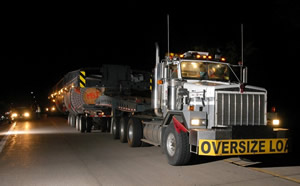
A semitrailer truck hauling a large industrial dryer slowly made its way through Minnesota July 25-26. The truck was bound for an ethanol plant in western North Dakota. Photo by David Gonzalez |
By Kevin Gutknecht
A semitrailer truck with a load that took up almost two lanes of a freeway moved through Minnesota early on the mornings of July 25-26. While its passing created a stir with the news media, the truck moved through the Twin Cities metro area without any traffic incidents.
Mn/DOT restricted the semitrailer’s movement to between midnight and 5 a.m. to avoid affecting traffic.
The semitrailer carried a large industrial dryer, bound for an ethanol plant in western North Dakota. The load was about 200 feet long, 18 feet wide, almost 15 feet high, and weighed approximately 450,000 pounds. Loads of this size require special permitting from Mn/DOT, and are sometimes referred to as “super loads.” The average truck load is about 80,000 pounds, according to Mn/DOT permitting officials.
The vehicle started its journey in Milwaukee, Wisc., traveling between the hours of 10 p.m. and 6 a.m. in that state. It crossed the Minnesota-Wisconsin border at about 2 a.m. July 25, going west on Interstate 94, north on I-694 and then west across the state on I-94. The semitrailer stopped for the day near Sauk Centre, Minnesota.
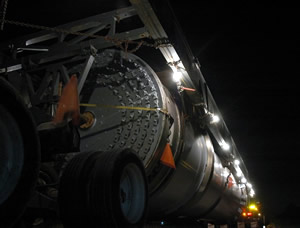
A rear view of the "super load," which was about 200 feet long, 18 feet wide, almost 15 feet high, and weighed approximately 450,000 pounds. The average truck load on Minnesota roads is about 80,000 pounds. Photo by David Gonzalez |
The Minnesota State Patrol provided an escort for the vehicle as it moved through the state.
Mn/DOT’s permitting office worked with the trucking company to get the vehicle its permit and plan the route. The truck driver was required to physically inspect the route before driving the super load to make sure there were no potential problems evident. The permitting office also checked with field staff at the various construction sites along the route to insure that these sites could accommodate the passing of the super load. It worked with district staff to ensure that the load could negotiate all bridges and overpasses on the route.
Mn/DOT’s Office of Communications began receiving calls from the news media regarding the super load on Sunday evening. The super load was evident on most Twin Cities television news programs Monday evening and Tuesday morning and was a subject of discussion on many radio news programs.
The final destination for the super load is Richardton, North Dakota, a small town west of Bismarck on I-94. The load was expected to arrive there Friday, July 28.
|
 |
|

|
 |
TABLE of CONTENTS
 |
Metro District employee scrapes by with bruises in nighttime work zone crash |
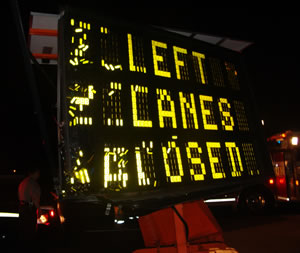
The message sign pulled by Metro District’s Kim Peterson remained eerily aglow after it was struck by a SUV during a nighttime paving operation. The crash destroyed the sign, its trailer and the truck pulling them. Photo by Ted Krinkie |
By Craig Wilkins
A Metro District employee escaped serious injury when her truck was struck by a sport utility vehicle during night maintenance operations July 23 on Interstate 35W in Roseville.
Kim Peterson, a transportation generalist at the Arden Hills truck station, received minor injuries when the SUV crashed into to her one-ton truck and the message sign trailer it was towing, said Jim Weiler, a district safety administrator.
Peterson’s truck was parked on the freeway’s shoulder as she waited for a paving operation to begin.
She was treated and released at an area hospital.
The driver of the car was hospitalized with extensive injuries.
The 11 p.m. crash destroyed the truck and the message board. The SUV first struck the message board trailer, then hit Peterson’s truck. The collision’s impact ripped open the compartment directly behind the driver’s seat.
Julie Bottolfson, Metro District’s safety services supervisor, said the incident underscores the need to remind motorists about safety.
“We have to constantly remind the public to avoid distracted driving and to stay alert for highway operations, whether they’re a large-scale construction project or a mobile maintenance operation,” she said.
|
 |
|

|
 |
TABLE of CONTENTS
 |
‘Intelligent compaction’ creates smart way to achieve uniform highway sub-grade design specifications |

A contractor’s employee demonstrates a roller equipped with IC technology during the Hwy 64 re-grading project open house. Photo by Nick Schreurs |
By Craig Wilkins
Got density?
Sub-grade and embankment designs that uniformly meet specifications for compaction, that is.
The crew re-grading Hwy 64 near Akeley in Hubbard County does, thanks in large part to using new “intelligent compaction” technology.
Other districts have used the technology on a small scale, but the Hwy 64 project is one of the first in the United States to use IC on a full-scale project basis.
Larry Randall, project supervisor with Bemidji/District 2, said the process enabled his crew members and the contractor to ensure uniform levels of sub-grade and embankment stiffness and density for the six-mile project.
As installing a new sub-grade for the project nears completion, Randall said using the new process provides quality assurance and a more realistic prediction of how well the roadway will perform after grading and paving are completed.
Using IC differs from standard quality assurance and control measures that are cumbersome and time-consuming and may not accurately determine the as-built project’s actual compaction levels, said John Siekmeier, IC project engineer with the Office of Materials.

Leaders in District 2’s use of intelligent compaction and associated research include (from left) Davin Wiesen, Midwest Contracting; Nick Schreurs, graduate engineer; Larry Randall, project supervisor, and Jim Bittmann, district soils engineer. Photo by Todd Vonasek |
Siekmeier said standard measurement practices provide data from only certain points along a project.
“Using point data makes it very difficult to assess both true quality and uniformity,” he said. “Uniformity of construction is critical in order to avoid costly pavement failures.”
IC technology, however, gives project managers a constant stream of data when a compaction roller equipped with on-board sensors moves across the construction area.
The process, Siekmeier said, provides a color-coded “map” of pavement conditions and alerts when rollers may need to adjust pressure settings as conditions change.
“We’ve found that data can be collected so quickly that roller operators can adjust their equipment settings as they work to ensure maximum levels of strength and uniformity,” Siekmeier said.
On the Hwy 64 project, Randall said, IC technology provided data that enabled roller operators and project staff to know when desired stiffness levels were reached. The data, he said helped eliminate the guesswork often involved and helped avoid under- or over-compacting the sub-grade materials.
Over-compaction, he said, wastes time and resources and can reduce the stiffness of embankments if previously compacted materials are broken down by excessive pounding.
District and project staff work closely with the Office of Materials, the Minnesota Road Research Project and researchers from Iowa State University at Ames to monitor IC technology use and provide data for other researchers as well.
A July 20 open house for the Hwy 64 project’s use of IC attracted highway engineers, researchers and other staff from state DOTs, county highway departments, the Federal Highway Administration, contractors and equipment manufacturers.
Another open house on IC technology was held at the Mn/ROAD facility on Interstate 94 near Monticello.
Randall said he’s convinced of the IC process’s value by its ability to reach compaction specifications, achieve uniformity and create potential time and cost savings.
“I’d use it again in the future,” he said.
|
 |
|

|
 |
TABLE of CONTENTS
 |
New session laws take effect Aug. 1 |
|
By Jeanne Aamodt
Although the 84th Legislature adjourned May 21, many of the laws it produced—ranging from tools for fighting identity theft to naming the Honeycrisp apple as the state fruit—go into effect Aug.1.
Among these are several laws related to transportation, including:
Low speed electric vehicles on residential roadways—This law allows electrically powered motor vehicles with a maximum operating speed of 25 mph to be operated on roadways where the speed limit is 35 mph or less. These vehicles are commonly known as neighborhood electric vehicles.
Commuter rail contracting and liability—This legislation defines certain commuter rail activities as serving a public purpose and a matter of public necessity. It enables the transportation commissioner or other public entity, such as the Northstar Corridor Development Authority, to contract with a railroad for commuter rail purposes. This law also contains provisions governing the liability associated with commuter rail, and permits the contract with the railroad to provide for allocation of financial responsibility, indemnification and the procurement of insurance for all types of claims or damages.
Shawn Silvera Memorial Highway—This law designates a portion of Interstate 35 and I-35W as the Shawn Silvera Memorial Highway . Silvera, a Lino Lakes police officer, was killed in the line of duty in September 2005. He was placing stop sticks on I-35 when struck by the vehicle of a suspect fleeing officers.
Mn/DOT housekeeping and property transfers bill—This bill includes several items, among them allowing Mn/DOT to enter into an agreement with the state of Iowa for construction of the Bigelow Bypass up to four miles into Iowa. Mn/DOT and Iowa are preparing to let a contract in December 2006 or early 2007 for construction of the Bigelow Bypass on Hwy 60 just across and north and south of the border with Iowa. The project extends 3.64 miles into Iowa.
The bill also allows the transfer of Hwy 242 between U.S. Hwy 10 and Hwy 65 from the state highway system to Anoka County and Hwy 294 from the state highway system to the city of Willmar.
Aviation planning and zoning requirements—This legislation repeals current statute requiring that a copy of aeronautics rules be mailed to the members of the public listed in that statute. This is no longer economical or practical compared with the use of e-mail and the Internet. By repealing this requirement, the agency will save resources for printing, handling and postage.
Eminent domain changes—Some legislation went into in effect before Aug.1, including modifications to eminent domain law, said Erik Rudeen, Government Affairs. Effective May 20, this legislation makes it harder for government to take private property and easier for property owners to ensure that they are justly compensated for the land they must sell for the public’s benefit.
The bill also limits the use of eminent domain to the acquisition of property that will be owned by the government or used for the functioning of public service corporations, such as utilities or railroads or, in limited cases, for economic development to remedy blighted, environmentally contaminated or abandoned land.
For more information on these laws and other transportation-related legislation, including the 2006 Omnibus Bonding Bill, visit the Government Affairs Web site at http://ihub.dot.state.mn.us/information/legislative2006/index.html.
|
 |
|

|
 |
TABLE of CONTENTS
 |
Cancer claims life of Crookston’s Scott Swenson |

Scott Swenson, a transportation materials technician with Bemidji/District 2 at Crookston, died July 12 from cancer. |
Scott Swenson, who was a transportation materials technician with Bemidji/District 2 at Crookston, died July 12 from cancer. He was 51.
His career with Mn/DOT began in 1989 at Crookston. He was a native of Kennedy, Minn., and graduated from the East Grand Forks Area Vocational Technical Institute with an associate degree in diesel mechanics.
Before joining Mn/DOT, Swenson worked as a mechanic and parts manager for several Crookston area farm implement dealers.
His survivors include his wife, Pamela Swenson, a son and a daughter.
Chris Johnson, district administrative manager, said Swenson’s loss is being felt throughout the district.
“Scott was a really upbeat, positive caring person who was very proud of his contributions to Mn/DOT,” she said. “He got along very well with his co-workers; we are lucky to have known and worked with him.”
|
 |
|

|
 |
TABLE of CONTENTS
 |
EDMS best practice approved for permits |
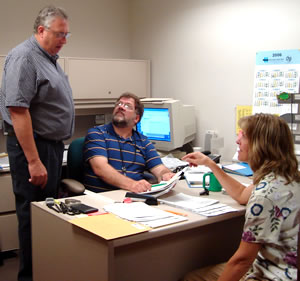
From left, Randy Meyers, management information systems, Tom Strieff, permits, and Judy Evers, Amininstration, were some of the members of the Rochester/District 6 EDMS pilot project team. Photo by Kristine Hernandez |
By Pam Newsome and Kay Korsgaard
The process for approving and tracking district permits may run a little more smoothly thanks to a recently approved best practice for the Electronic Document Management System.
It began in 2004 when District 6 permits supervisor Larry Pederson was approaching retirement. He was concerned that his successor would not be able to locate records for permits for driveways, utilities, mowing and the myriad other permits and license agreements his office handled.
Even if his replacement was a person from another district, getting up-to-speed with his system of filing might be difficult, since each district handled the tracking and filing of permit documents differently.
Nelrae Succio, Rochester/District 6 district engineer, saw the potential for EDMS to provide a solution and asked the EDMS team for help. A pilot project to study the workflow and archiving tasks needed to review and issue permits in the district began.
Goals of the pilot were to:
- Define and develop a workflow process to reduce the time needed to route and issue a permit
- Create easily accessible, permanent records for permits
“This is the first EDMS project to incorporate document management, document workflow and records management,” says Nancy Melvin, EDMS manager. “This approach will be used in all future EDMS design and implementation.
Electronic Document Management System
The Electronic Document Management System is the department standard for life-cycle management of Mn/DOT business documents, document workflow and records.
Current projects include the vacancy filling process and the consultant contracting processes involving the Office of Technical Support, districts and a pilot in the Bridge Office.
EDMS best practices go through three phases:
-
Study the current process and associated documents
-
Use a pilot project to develop a best practice reviewed and approved by key Central Office and district representatives for how to use EDMS to manage document workflow and storage
-
Implement as a standard practice statewide
For more information, see:
|
“Nelrae allowed us to use the district as a laboratory to test our work in a real-life situation with real-life customers,” Melvin said.
Dave Pehoski, workflow coordinator for EDMS, noted that one of the most valuable aspects of this project was discovering variations in how permits are issued around the state. As the project entered the design and testing phase, all districts provided excellent input and took ownership of the final outcome.
A member of the management team that reviewed and endorsed the proposed best practice, Dave Solsrud, Willmar/District 8 Construction and Operations assistant district engineer, credited the team for incorporating these variations in process and customer wishes into the process flow.
“The department will benefit overall as a result of greater access to permit records,” he said.
Other members of the management review team were E. Buck Craig, Metro District, and Steve Lund, District 6. The proposed best practice was approved by OMG chair James Curran and by Bob Winter, District Operations division director, and will now be implemented departmentwide. The EDMS team will continue to provide training and support in all districts.
For Tom Streiff, District 6 permits supervisor, the EDMS Best Practice has become a normal part of his process.
"I scan documents into the system to route things so that everyone can be looking at the same documents at the same time. As we issue the permit and build on the documentation, we will be able to ensure that all needed documents are in the system. Eventually we should be able to issue a permit with no paper," he said.
"It's a flexible way to file, share and retrieve documents needed for the permitting process," Streiff said.
Additional information:
|
 |
|

|
 |
TABLE of CONTENTS
 |
National transportation officials scan Mn/DOT’s right of way, utility best practices |
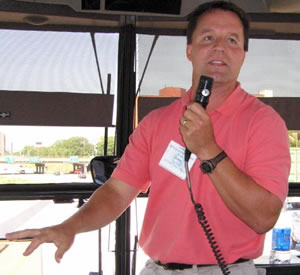
John Griffith, Metro District area engineer, provides the bus tour group with information about the I-35W/Hwy 62 reconstruction project. Photo courtesy of Cambridge Systematics, Inc. |
By Donna Lindberg
Right of way and utility officials from around the country on July 14 took a firsthand look at some of Minnesota’s highway and rail projects that required new, unique or extraordinary efforts for relocation of utilities and acquisition of right of way.
The National Cooperative Highway Research Program and Federal Highway Administration sponsored the scanning tour, whose purpose was to help states reduce the time for delivering right of way clearance and utility relocation before construction activities can begin.
“Utility relocation and right of way acquisition have been identified as reasons for delays in design and construction phases of projects,” said Ann Driver, permit specialist, Utility and Agreements Unit. “At a time of reducing staff and budgets, best management practices help DOTs meet their scheduled commitments.”
Best management practices shared included:
- The use of Mn/DOT’s new utility coordination process and policy
- Incorporation of utility relocation services in construction contracts
- Long-range planning and coordination of upcoming projects for timely right of way acquisition and relocation of utilities
- Ways to use subsurface utility engineering and alternative design procedures to relocate utilities
- Right of way electronic document management and training
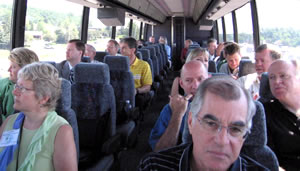
Transportation officials from around the country toured Mn/DOT projects where best practices in right of way acquisition and utility relocation were used. Left side front is Marilyn Remer, Utilities. Photo courtesy of Cambridge Systematics, Inc. |
Mn/DOT representatives presented the department’s right of way acquisition process and programs and demonstrated use of geographic information systems and visualization. Participants also took a bus tour of the planned Hwy 62/Interstate 35W Crosstown and current I-494 projects to see where the new processes were used and how they worked.
“Similar tours were also conducted in Florida and Texas, states that have developed new practices for planning, designing and negotiating right of way acquisition and utility relocation on projects,” Driver said.
“Best practices shared during our visit to Minnesota will be formulated into a report to help other states and the FHWA improve right of way acquisition and utility relocation policies and practices,” said Chris Porter, Cambridge Systematics, Inc. “An executive summary, available in early fall, and final report, to be completed by the end of the year, will be of interest to mainly right of way and utility officials, but will also help planners, designers, and managers expedite delivery of transportation improvement projects.”
|
 |
|

|
 |
TABLE of CONTENTS
 |
Planning efforts receive two national awards |
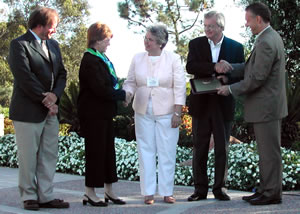
Accepting the awards for Mn/DOT are Abby McKenzie, OIM director (center) and Randy Halvorson, Program Management Division director (second from right). Presenting the awards are (from left) Charles Goodman, Federal Transit Administration; Cynthia Burbank, Federal Highway Administration, and Jeffrey Lambert, American Planning Association. Photo courtesy of Transportation Research Board |
By Craig Wilkins
Mn/DOT’s commitment to performance-based planning helped the agency earn two national awards from the Federal Highway Administration and the Federal Transit Administration.
The first award recognizes the department’s statewide and district long-range transportation plans. The second cites Mn/DOT’s Statewide Freight Plan.
In July, Mn/DOT earned two of 10 national awards presented by the federal agencies during the annual meeting of the Transportation Research Board held in California.
The planning process and the resultant plans were honored for incorporating quantifiable, performance-based goals and measures to assess future transportation needs and priorities. The new statewide and district transportation plans use data such as physical condition of roadway pavement and bridges and hours of freeway congestion to help shape the department’s investment priorities.
Efforts to ensure public involvement by people of color, recent immigrants and other groups often under-represented in the planning process also drew notice.
The planning directors in each district, working with their management teams, led the development of the district plans, according to Peggy Reichert, Statewide Planning and Analysis Section director, Office of Investment Management.
The second award honors development of Mn/DOT’s Statewide Freight Plan. The freight plan was cited for its comprehensive scope to identify issues and trends and its development of policies needed to address them.
The Office of Freight and Commercial Vehicle Operations estimates that more than one trillion tons of interstate and intrastate freight will be shipped in Minnesota by 2020, a 60 percent increase compared with 2001.
Like the Statewide Transportation Plan, the freight plan uses performance measures to monitor use of the system and to develop polices and strategies to meet Minnesota’s rapidly expanding set of transportation needs.
Abby McKenzie, OIM director, said the awards stem from leadership and vision provided by Randy Halvorson, Program Management Division director; the work done by each district and office, and Mn/DOT’s collaboration with the metropolitan planning organizations, regional development commissions and other transportation partners.
Managers and staff from OIM and OFCVO also received the “Blue Light Special” award for their accomplishments at the July 18 and July 25 meetings of the commissioner’s staff. Deputy Commissioner Doug Differt presented the award.
|
 |
|

|
 |
TABLE of CONTENTS
 |
Two district engineers speak their voices; so can you... |
In the current issues of their district newsletters, District Engineers Lee Berget (Detroit Lakes/District 4) and Nelrae Succio (Rochester/District 6) bring a personal touch to local operations with their quarterly columns.
Berget, in tracing some of the issues the department has faced during the past several decades, notes how "the more things change, the more they stay the same." He poses this question to a hypothetical person 20 years from now: "...Dealing with budget issues, demanding programming needs, strategic staffing issues…did we make a difference?" You can read more of what he has to say at http://ihub.d4.dot.state.mn.us/newsletter/#1.
At the other end of the state, Succio talks about District 6's accomplishments during the past six months and looks ahead at the planning for the FY 2008-09 biennial budget cycle. Read her words at http://ihub.d6.dot.state.mn.us/newsletter/#Z1.
* * * * *
In addition to these two voices, Mn/DOT Newsline would like to hear yours. The Voices section of the redesigned newsletter is reserved for commentaries from Mn/DOT management and employees on topics of departmentwide interest.
In recent issues, for example, you've heard one employee express what the vacation donation program personally has meant to him, and another describe what it's been like growing up, literally, with the interstate system. You should know that Mn/DOT Newsline will not print libelous statements or personal attacks, and reserves the right to edit articles for length and clarity. Other guidelines you should follow include:
-
Be brief (300-400 words)
-
Relate your comments to the business of Mn/DOT
-
Sign your submission with your name, office and phone number
Deadline for submissions is one week prior to Wednesday's publication. Contact Chris Joyce, editor, for more information, 651/282-6283. We look forward to hearing from you.
|
 |
|
| |
|



